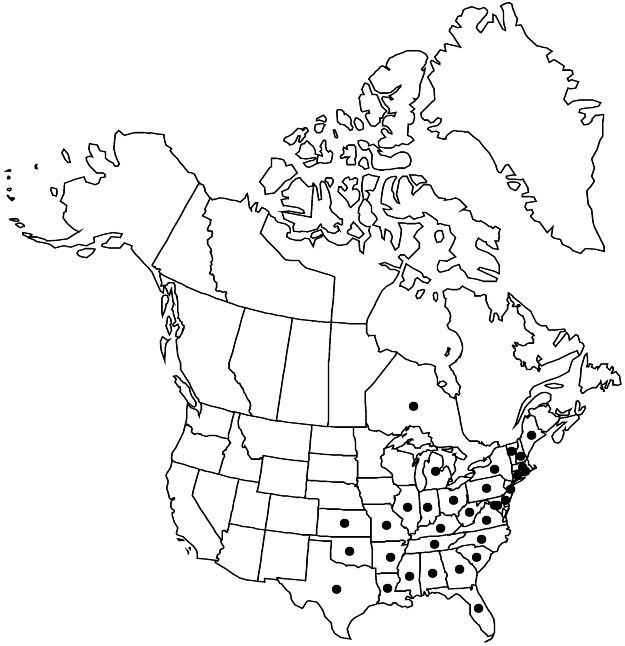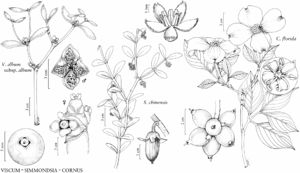Cornus florida
Sp. Pl. 1: 117. 1753.
Trees to 20 m, flowering at 2 m. Stems clustered, occasionally decumbent and rooting at nodes, bark corky, forming rectangular plates 0.5–1 cm wide; branchlets green, maroon, or red, appressed-hairy; lenticels maroon swellings. Leaves: petiole 3–20 mm; blade ovate, elliptic, or obovate, 5–12 × 2–7 cm, base cuneate to rounded, apex abruptly acuminate, abaxial surface whitish, appressed-hairy, tufts of erect hairs present in axils of secondary veins, adaxial surface dark green, appressed-hairy; secondary veins 5–7 per side, most arising from proximal 1/2. Inflorescences flat-topped, 1–2 cm diam., 15–30-flowered, subtended by 2 pairs of cataphylls; peduncle 10–20 mm; petaloid bracts 4, surrounding and enclosing inflorescence through winter, white or tinged with red and with brown or white callous at apex, obovate to obcordate, 2–6 × 1–4.5 cm, apex rounded or emarginate. Flowers: hypanthium appressed-hairy; sepals 0.5–0.8 mm; petals cream or yellow-green, 3–3.5 mm. Drupes usually red, rarely yellow, drying black, spreading from each other, round in cross section, 13–18 × 6–9 mm; stone ellipsoid, 10–12 × 4–7 mm, smooth. 2n = 44.
Phenology: Flowering Mar–Jun; fruiting Aug–Oct.
Habitat: Deciduous, mixed, and pine forests.
Elevation: 0–2000 m.
Distribution

Ont., Ala., Ark., Conn., Del., D.C., Fla., Ga., Ill., Ind., Kans., Ky., La., Maine, Md., Mass., Mich., Miss., Mo., N.H., N.J., N.Y., N.C., Ohio, Okla., Pa., R.I., S.C., Tenn., Tex., Vt., Va., W.Va., e Mexico.
Discussion
Mexican populations of Cornus florida sometimes have been treated as C. urbinia Rose or C. florida subsp. urbinia (Rose) Rickett, distinguished primarily by bract size, shape, and apical cohesion following expansion. North American and Mexican populations overlap in these characters and are treated here as a single taxon.
Cornus florida, the state tree of Missouri and Virginia and the state flower of North Carolina, is an understory tree that can form spectacular displays when flowering. Cultivars with pink to red bracts are often planted as ornamentals. Dogwood anthracnose is causing serious declines in C. florida throughout its range.
Selected References
None.
